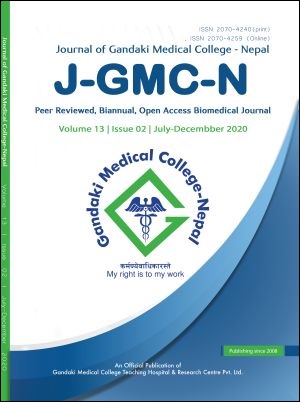Extracorporeal Septoplasty for anterior septal deviation and deviated nose
DOI:
https://doi.org/10.3126/jgmcn.v13i2.30145Keywords:
Deviated nose, Extracorporeal septoplasty, RhinoplastyAbstract
Background: Deviated nose and septum is challenging, which results in functional and cosmetic problems. It blocks the nose and makes person ugly. The classical septoplasty approach becomes unsuitable for such severe deviations. Extracorporeal septoplasty is a surgical technique for correcting a severely deviated nasal septum, which also corrects the aesthetic part of the nose. The objective of this study was to describe extracorporeal septoplasty for Deviated nose and anterior septal deviation.
Methods: A prospective observational outcome study was done in patients with Deviated nose and anterior septal deviation who underwent extracorporeal septorhinoplasty. Preoperative and postoperative evaluation was performed using a photographs, computerized tomography (CT) scan, and Nasal obstruction symptoms evaluation scale.
Results: A total of 38 consecutive patients were enrolled, out of which majority were male (24, 63.2%) with only 14 (36.8%) female. The ratio of male female was 1.7:1. All the subjects had deviated nasal septum. Among these, nose deviation was externally noticeable in 20 (52.6%) cases, whereas in remaining cases it was inconspicuous. There were 21(55.3%) patients where Nasal Septum was deviated to the right side followed by 17(44.7%) with left side deviation. There was a significant improvement in mean nasal obstruction symptoms evaluation postoperatively (71.2 versus 22.7 with p value equal to 0.01). According to the pre and postoperative photographs 17(44.7%) patients had good improvement, nine (23.6%) showed excellent improvement and the result was fair in six (15.7%) patients.
Conclusions: Extracorporeal septoplasty is effective in improving both nasal airway function and aesthetics in patients with severe Nasal Septal deviation.
Downloads
Downloads
Published
How to Cite
Issue
Section
License
This license allows reusers to distribute, remix, adapt, and build upon the material in any medium or format for noncommercial purposes only, and only so long as attribution is given to the creator.




